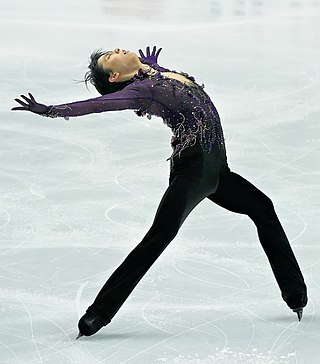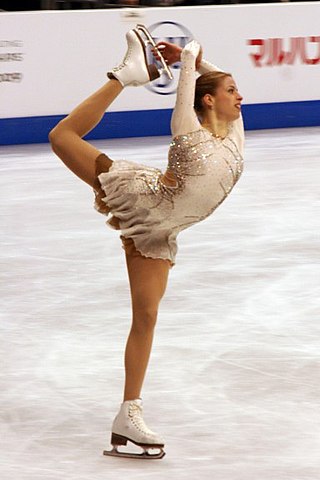
Figure skating is a sport in which individuals, pairs, or groups perform on figure skates on ice. It was the first winter sport to be included in the Olympic Games, when it was contested at the 1908 Olympics in London. The Olympic disciplines are men's singles, women's singles, pair skating, and ice dance; the four individual disciplines are also combined into a team event, which was first included in the Winter Olympics in 2014. The non-Olympic disciplines include synchronized skating, Theater on Ice, and four skating. From intermediate through senior-level competition, skaters generally perform two programs, which, depending on the discipline, may include spins, jumps, moves in the field, lifts, throw jumps, death spirals, and other elements or moves.
Figure skating jumps are an element of three competitive figure skating disciplines: men's singles, women's singles, and pair skating – but not ice dancing. Jumping in figure skating is "relatively recent". They were originally individual compulsory figures, and sometimes special figures; many jumps were named after the skaters who invented them or from the figures from which they were developed. It was not until the early part of the 20th century, well after the establishment of organized skating competitions, when jumps with the potential of being completed with multiple revolutions were invented and when jumps were formally categorized. In the 1920s Austrian skaters began to perform the first double jumps in practice. Skaters experimented with jumps, and by the end of the period, the modern repertoire of jumps had been developed. Jumps did not have a major role in free skating programs during international competitions until the 1930s. During the post-war period and into the 1950s and early 1960s, triple jumps became more common for both male and female skaters, and a full repertoire of two-revolution jumps had been fully developed. In the 1980s men were expected to complete four or five difficult triple jumps, and women had to perform the easier triples. By the 1990s, after compulsory figures were removed from competitions, multi-revolution jumps became more important in figure skating.

Surya Varuna Claudine Bonaly is a French-born retired competitive figure skater. She is a three-time World silver medalist (1993–1995), a five-time European champion (1991–1995), the 1991 World Junior Champion, and a nine-time French national champion (1989–1997).

Midori Ito is a retired Japanese figure skater. She is the 1989 World champion and the 1992 Olympic silver medalist. She is the first woman to land a triple-triple jump combination and a triple Axel in competition. At the 1988 Calgary Olympics, she became the first woman to land seven triple jumps in an Olympic free skating competition. She is widely recognised as one of the best figure skaters of all time.
The Salchow jump is an edge jump in figure skating. It was named after its inventor, Ulrich Salchow, in 1909. The Salchow is accomplished with a takeoff from the back inside edge of one foot and a landing on the back outside edge of the opposite foot. It is "usually the first jump that skaters learn to double, and the first or second to triple". Timing is critical because both the takeoff and landing must be on the backward edge. A Salchow is deemed cheated if the skate blade starts to turn forward before the takeoff, or if it has not turned completely backward when the skater lands back on the ice.
The toe loop jump is the simplest jump in the sport of figure skating. It was invented in the 1920s by American professional figure skater Bruce Mapes. The toe loop is accomplished with a forward approach on the inside edge of the blade; the skater then switches to a backward-facing position before their takeoff, which is accomplished from the skater's right back outside edge and left toepick. The jump is exited from the back outside edge of the same foot. It is often added to more difficult jumps during combinations and is the most common second jump performed in combinations. It is also the most commonly attempted jump.
The loop jump is an edge jump in the sport of figure skating. The skater executes it by taking off from the back outside edge of the skating foot, turning one rotation in the air, and landing on the back outside edge of the same foot. It is often performed as the second jump in a combination.
The following is a glossary of figure skating terms, sorted alphabetically.

Single skating is a discipline of figure skating in which male and female skaters compete individually. Men's singles and women's singles are governed by the International Skating Union (ISU). Figure skating is the oldest winter sport contested at the Olympics, with men's and women's single skating appearing as two of the four figure skating events at the London Games in 1908.
The short program of figure skating is the first of two segments of competitions, skated before the free skating program. It lasts, for both senior and junior singles and pair skaters, 2 minutes and 40 seconds. In synchronized skating, for both juniors and seniors, the short program lasts 2 minutes and 50 seconds. Vocal music with lyrics is allowed for all disciplines since the 2014-2015 season. The short program for single skaters and for pair skaters consists of seven required elements, and there are six required elements for synchronized skaters.

A quad, or quadruple, is a figure skating jump with at least four revolutions. All quadruple jumps have four revolutions, except for the quadruple Axel, which has four and a half revolutions. The quadruple toe loop and quadruple Salchow are the two most commonly performed quads. Quadruple jumps have become increasingly common among World and Olympic level men's single skaters, to the point that not performing a quad in a program has come to be seen as a severe handicap. This phenomenon is often referred to as the "quad revolution". Since 2018, quadruple jumps have also become an increasingly common feature of women's skating, although they are not allowed under the International Skating Union ("ISU") rules in the ladies' short program. The first person to land a ratified quadruple jump in competition was Canadian Kurt Browning in 1988. Japanese skater Miki Ando became the first female to do so, in 2002.

Keegan Messing is a Canadian-American retired figure skater. Representing Canada, he has competed at two Winter Olympic Games in 2018 and 2022. He has also appeared at three World Championships, placing as high as sixth. He is the 2023 Four Continents silver medalist, 2021 CS Golden Spin of Zagreb champion, a two-time Nebelhorn Trophy champion, and a two-time Grand Prix medalist. At the national level, he is a two time Canadian national champion.
The Axel jump or Axel Paulsen jump, named after its inventor, Norwegian figure skater Axel Paulsen, is an edge jump performed in figure skating. It is the sport's oldest and most difficult jump, and the only basic jump in competition with a forward take-off, which makes it the easiest to identify. A double or triple Axel is required in both the short program and the free skating segment for junior and senior single skaters in all events sanctioned by the International Skating Union (ISU).

Jason Lawrence Brown is an American figure skater. He is a nine-time Grand Prix medalist, a two-time Four Continents medalist, and the 2015 U.S. national champion. Earlier in his career, he became a two-time World Junior medalist, the 2011 Junior Grand Prix Final champion, and the 2010 junior national champion.

Shoma Uno is a Japanese figure skater. He is a three-time Olympic medalist, a two-time World champion and a two-time World silver medalist, the 2022–23 Grand Prix Final champion, the 2019 Four Continents champion, the 2017 Asian Winter Games champion, and a five-time Japanese national champion. At the junior level, Uno is the 2015 World Junior champion, 2014–15 Junior Grand Prix Final champion, and 2012 Youth Olympic silver medalist.

Jin Boyang is a Chinese figure skater. He is a two-time World bronze medalist (2016–2017), the 2018 Four Continents champion, a two-time Four Continents silver medalist, the 2017 Asian Winter Games silver medalist, and a five-time Chinese national champion. On the junior level, he is the 2015 World Junior silver medalist and the 2013 JGP Final champion. He is the first Chinese skater to medal in the men's singles at the World Championships.

Rika Kihira is a Japanese figure skater. She is a two-time Four Continents champion, the 2018 Grand Prix Final champion, a four-time Grand Prix series medalist, a two-time International Challenge Cup champion, and a two-time Japanese national champion. As of 25 March 2022, Kihira is the twelfth highest ranked women's singles skater in the world by the International Skating Union.

Alexandra "Sasha" Vyacheslavovna Trusova is a Russian figure skater. She is the 2022 Olympic silver medalist, the 2021 World bronze medalist, a two-time European bronze medalist, the 2019 Grand Prix Final bronze medalist, the 2019 Skate Canada champion, the 2019 Rostelecom Cup champion, the 2019 CS Ondrej Nepela Memorial champion, the 2021 U.S. Classic champion, and the 2021 Skate America champion. Domestically, she is the 2022 Russian national champion, the 2019 silver medalist, and the 2020 and 2021 bronze medalist. At the junior level, she is a two-time Junior World Champion, the 2018 Junior Grand Prix Final champion, the 2019 Junior Grand Prix Final silver medalist, a four-time champion on the Junior Grand Prix series, and a two-time Russian Junior national champion.

Yuma Kagiyama is a Japanese figure skater. He is the 2022 Olympic silver medalist, a two-time World silver medalist, the 2020 Four Continents bronze medalist, and a three-time Japanese national bronze medalist. On the junior level, he is the 2020 Youth Olympic champion, the 2020 World Junior silver medalist, and the 2019–20 Japan Junior national champion. Kagiyama is also a bronze medalist in the team event at the 2022 Winter Olympics. He is well known for his skating skills and consistency.

Ilia Malinin is an American figure skater. He is the 2023 World bronze medalist, the 2022-23 Grand Prix Final bronze medalist, the 2022 Skate America champion, the 2022 Grand Prix of Espoo champion, the 2022 CS U.S. Classic champion, 2021 CS Cup of Austria bronze medalist, the 2023 U.S. national champion, and the 2022 U.S. national silver medalist. At the junior level, Malinin is the 2022 World Junior champion, 2021 JGP France I champion, and 2021 JGP Austria champion. He currently holds the world junior record for the men's short program, free skate, and combined score.












